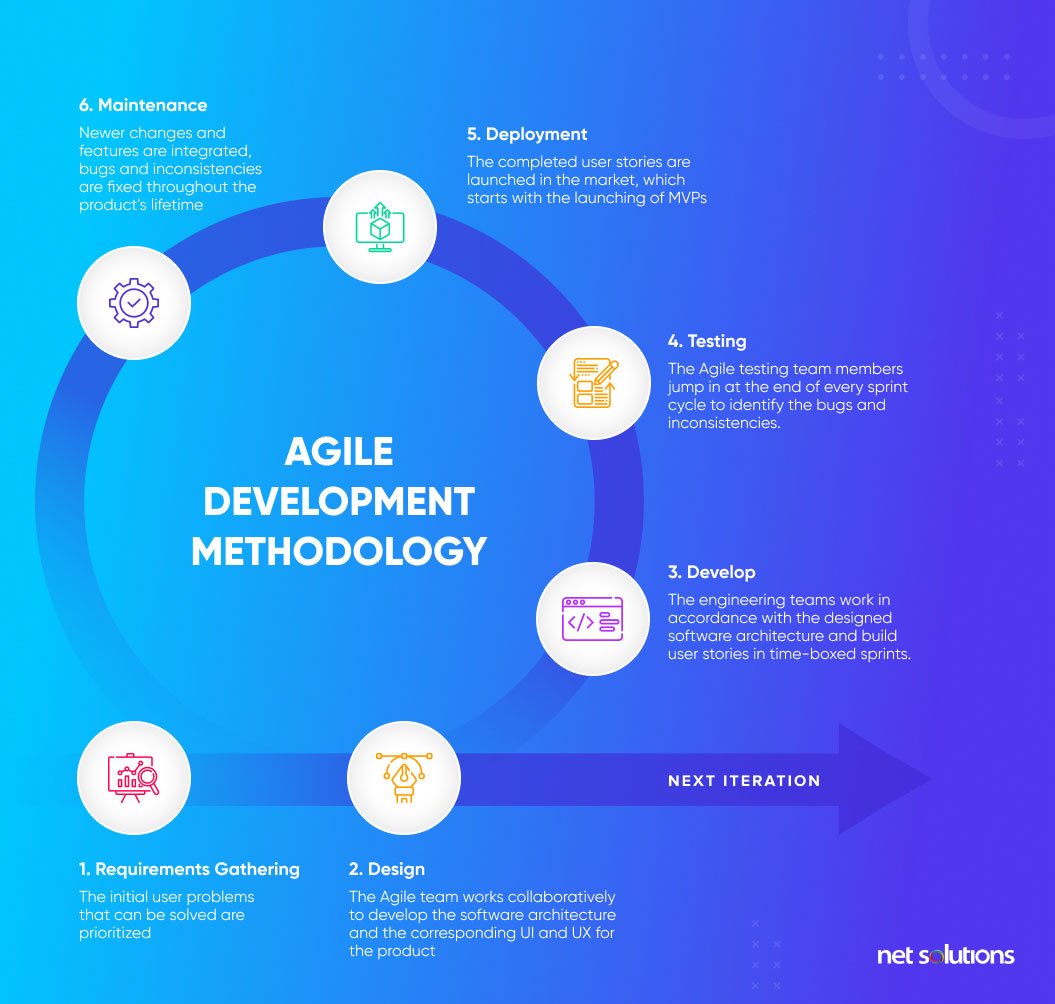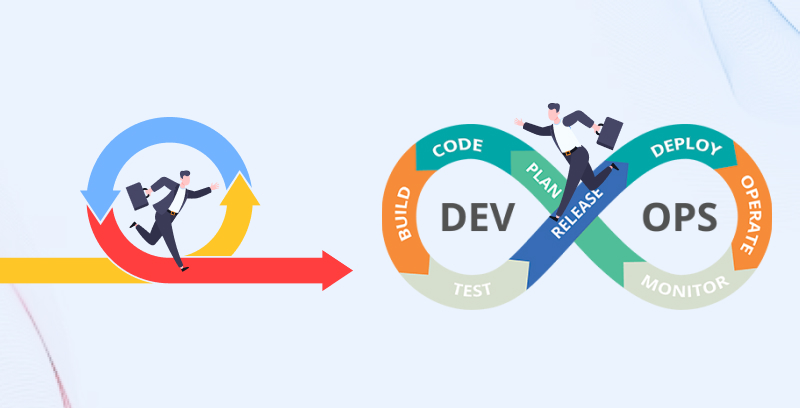What is Agile Development: Understanding the Core Principles
Agile development methodologies have revolutionized the way software is developed, emphasizing flexibility, collaboration, and continuous improvement. The term “agile” was first introduced in the Agile Manifesto in 2001, which emphasized the importance of individuals and interactions, working software, customer collaboration, and responding to change.
At its core, agile development is an iterative and incremental approach to software development, focusing on delivering working software in short cycles, known as sprints or iterations. This approach enables teams to respond quickly to change, prioritize features based on customer needs, and continuously improve the development process.
The key principles of agile development methodologies include:
- Flexibility: Agile teams are adaptable and responsive to change, prioritizing customer needs and delivering working software in short cycles.
- Collaboration: Agile teams work closely with customers, stakeholders, and each other to ensure that everyone is aligned and working towards a common goal.
- Continuous improvement: Agile teams continuously reflect on their processes and practices, identifying areas for improvement and implementing changes to optimize the development process.
- Customer-centricity: Agile teams prioritize customer needs, delivering software that meets their requirements and exceeds their expectations.
By embracing these principles, agile development methodologies enable teams to deliver high-quality software quickly and efficiently, while also fostering a culture of collaboration, innovation, and continuous improvement.
Agile development methodologies have been widely adopted across various industries, from software development to marketing and finance. By understanding the core principles of agile development, teams can unlock the full potential of this approach and achieve greater success in their projects.
How to Implement Agile in Your Team: A Step-by-Step Approach
Implementing agile development methodologies in a team requires careful planning, execution, and ongoing improvement. To help teams get started, we’ve outlined a step-by-step approach to implementing agile, including setting up agile frameworks, defining roles and responsibilities, and establishing a continuous improvement process.
Step 1: Set Up Agile Frameworks
Agile frameworks provide a structured approach to implementing agile methodologies. Popular frameworks include Scrum, Kanban, and Lean. When selecting a framework, consider the team’s size, project complexity, and organizational culture. For example, Scrum is well-suited for teams with a clear product owner and a defined set of requirements, while Kanban is better suited for teams with a high volume of incoming requests.
Step 2: Define Roles and Responsibilities
Agile teams require clear roles and responsibilities to ensure effective collaboration and decision-making. Key roles include:
- Product Owner: responsible for defining and prioritizing product requirements
- Scrum Master: responsible for facilitating Scrum processes and removing impediments
- Development Team: responsible for developing software in short cycles
Step 3: Establish a Continuous Improvement Process
Agile teams must continuously reflect on their processes and practices to identify areas for improvement. Regular retrospectives and feedback sessions help teams identify and address issues, such as communication breakdowns, inefficient workflows, or inadequate training.
Step 4: Develop a Culture of Collaboration and Transparency
Agile teams thrive in a culture of collaboration and transparency. Encourage open communication, active listening, and constructive feedback. Use tools like whiteboards, sticky notes, and collaboration software to facilitate communication and visibility.
Step 5: Monitor Progress and Adjust
Agile teams must continuously monitor progress and adjust their approach as needed. Use metrics like velocity, lead time, and customer satisfaction to measure progress and identify areas for improvement.
By following these steps, teams can successfully implement agile development methodologies and reap the benefits of increased flexibility, collaboration, and continuous improvement.
Remember, agile is a journey, not a destination. Be patient, persistent, and open to change, and your team will be well on its way to mastering agile development methodologies.
Scrum vs Kanban: Choosing the Right Agile Framework for Your Project
When it comes to implementing agile development methodologies, teams often face a dilemma: Scrum or Kanban? Both frameworks have their strengths and weaknesses, and choosing the right one depends on the project’s specific needs and requirements.
Scrum is a popular agile framework that emphasizes teamwork, accountability, and iterative progress toward well-defined goals. It is well-suited for projects with a clear product owner, a defined set of requirements, and a team that is willing to work in short cycles (sprints). Scrum’s strengths include:
- Clear roles and responsibilities
- Regular sprint planning and review
- Emphasis on teamwork and collaboration
However, Scrum can be inflexible and may not be suitable for projects with rapidly changing requirements or a high volume of incoming requests.
Kanban, on the other hand, is a more flexible agile framework that emphasizes continuous flow and delivery. It is well-suited for projects with a high volume of incoming requests, rapidly changing requirements, or a team that is not willing to work in short cycles. Kanban’s strengths include:
- Flexibility and adaptability
- Continuous flow and delivery
- Visualization of work and workflow
However, Kanban can be more challenging to implement and may require more discipline and self-organization from the team.
So, how do you choose between Scrum and Kanban? Consider the following factors:
- Project complexity and requirements
- Team size and dynamics
- Organizational culture and values
- Desired level of flexibility and adaptability
Ultimately, the choice between Scrum and Kanban depends on the specific needs and requirements of your project. By understanding the strengths and weaknesses of each framework, you can make an informed decision and choose the approach that best suits your team and project.
Remember, agile development methodologies are not a one-size-fits-all solution. Be flexible, adapt to changing requirements, and continuously improve your processes and practices to achieve success.
Agile Project Management Tools: A Review of Top Solutions
Agile project management tools are essential for teams to manage and track their work, collaborate with stakeholders, and deliver high-quality software quickly and efficiently. With so many tools available, it can be challenging to choose the right one for your team. In this article, we’ll review some of the top agile project management tools, including Jira, Trello, and Asana, and provide recommendations for different project types.
Jira is a popular agile project management tool that offers a range of features, including project planning, issue tracking, and collaboration. It’s well-suited for large and complex projects, and is widely used in the software development industry. Jira’s strengths include:
- Comprehensive project planning and tracking
- Issue tracking and management
- Collaboration and communication tools
However, Jira can be complex and overwhelming for small teams or simple projects.
Trello is a visual project management tool that uses boards, lists, and cards to organize and track work. It’s well-suited for small to medium-sized projects, and is popular among teams that prefer a more flexible and adaptable approach. Trello’s strengths include:
- Visual and intuitive interface
- Flexible and adaptable
- Easy to use and learn
However, Trello may not be suitable for large and complex projects, and lacks some of the advanced features offered by Jira.
Asana is a work management platform that helps teams stay organized and on track. It’s well-suited for teams that need to manage multiple projects and tasks, and is popular among teams that prefer a more structured and organized approach. Asana’s strengths include:
- Comprehensive task and project management
- Customizable workflows and templates
- Integration with other tools and services
However, Asana may not be suitable for teams that prefer a more flexible and adaptable approach, and can be overwhelming for small teams or simple projects.
When choosing an agile project management tool, consider the following factors:
- Project size and complexity
- Team size and dynamics
- Desired level of flexibility and adaptability
- Integration with other tools and services
Ultimately, the right tool for your team will depend on your specific needs and requirements. By understanding the strengths and weaknesses of each tool, you can make an informed decision and choose the tool that best suits your team and project.
Overcoming Common Agile Implementation Challenges
Implementing agile development methodologies can be a challenging and complex process, especially for teams that are new to agile. Common challenges that teams face when implementing agile include resistance to change, lack of training, and inadequate resources. In this article, we’ll discuss these challenges and provide strategies for overcoming them.
Resistance to Change
One of the biggest challenges that teams face when implementing agile is resistance to change. Agile requires a significant shift in mindset and culture, and some team members may be hesitant to adopt new practices and processes. To overcome this challenge, it’s essential to communicate the benefits of agile and involve team members in the implementation process.
Lack of Training
Another common challenge that teams face when implementing agile is a lack of training. Agile requires a specific set of skills and knowledge, and team members may need training to understand the principles and practices of agile. To overcome this challenge, it’s essential to provide training and coaching to team members, and to ensure that they have the necessary skills and knowledge to implement agile effectively.
Inadequate Resources
Inadequate resources is another common challenge that teams face when implementing agile. Agile requires a significant amount of resources, including time, money, and personnel. To overcome this challenge, it’s essential to ensure that the team has the necessary resources to implement agile effectively, and to prioritize the allocation of resources to ensure that the team has what it needs to succeed.
Strategies for Overcoming Agile Implementation Challenges
To overcome the challenges of implementing agile, teams can use a variety of strategies, including:
- Communicating the benefits of agile and involving team members in the implementation process
- Providing training and coaching to team members
- Ensuring that the team has the necessary resources to implement agile effectively
- Prioritizing the allocation of resources to ensure that the team has what it needs to succeed
- Encouraging a culture of continuous improvement and learning
By using these strategies, teams can overcome the challenges of implementing agile and ensure that they are able to implement agile development methodologies effectively.
Agile development methodologies are a powerful tool for teams that want to improve their software development processes and deliver high-quality software quickly and efficiently. By understanding the challenges of implementing agile and using strategies to overcome them, teams can ensure that they are able to implement agile effectively and achieve their goals.
Measuring Agile Success: Key Metrics and Performance Indicators
Measuring the success of agile development methodologies is crucial to understanding the effectiveness of the approach and identifying areas for improvement. In this article, we’ll discuss key metrics and performance indicators for measuring agile success, including velocity, lead time, and customer satisfaction.
Velocity
Velocity is a measure of the amount of work that a team can complete during a sprint or iteration. It’s a key metric for measuring agile success, as it provides insight into the team’s productivity and efficiency. To calculate velocity, teams can use the following formula:
Velocity = (Total Story Points / Number of Sprints)
Lead Time
Lead time is the time it takes for a feature or requirement to go from concept to delivery. It’s a key metric for measuring agile success, as it provides insight into the team’s ability to deliver software quickly and efficiently. To calculate lead time, teams can use the following formula:
Lead Time = (Average Time to Deliver a Feature / Number of Features)
Customer Satisfaction
Customer satisfaction is a key metric for measuring agile success, as it provides insight into the quality of the software and the team’s ability to meet customer needs. To measure customer satisfaction, teams can use surveys, feedback forms, or other metrics such as Net Promoter Score (NPS).
Other Key Metrics and Performance Indicators
In addition to velocity, lead time, and customer satisfaction, there are several other key metrics and performance indicators that teams can use to measure agile success, including:
- Defect density: the number of defects per unit of code
- Code coverage: the percentage of code that is covered by automated tests
- Deployment frequency: the frequency at which software is deployed to production
- Mean time to recovery (MTTR): the time it takes to recover from a failure or outage
Tracking and Analyzing Metrics
To track and analyze metrics, teams can use a variety of tools and techniques, including:
- Agile project management tools such as Jira, Trello, and Asana
- Automated testing and continuous integration tools such as Jenkins and Travis CI
- Monitoring and logging tools such as Splunk and ELK
- Surveys and feedback forms to measure customer satisfaction
By tracking and analyzing these metrics, teams can gain valuable insights into their agile development methodologies and identify areas for improvement.
Scaling Agile: Strategies for Large and Distributed Teams
As agile development methodologies continue to gain popularity, many organizations are looking for ways to scale agile to large and distributed teams. Scaling agile requires careful planning, coordination, and communication to ensure that all team members are aligned and working towards a common goal.
Agile Frameworks for Scaling
There are several agile frameworks that are designed specifically for scaling agile to large and distributed teams. Two popular frameworks are SAFe (Scaled Agile Framework) and LeSS (Large-Scale Scrum).
SAFe is a framework that provides a structured approach to scaling agile, with a focus on alignment, built-in quality, and transparency. It is designed for large and complex projects, and provides a clear framework for scaling agile to multiple teams.
LeSS is a framework that is designed for large and distributed teams, with a focus on simplicity, flexibility, and scalability. It is based on the principles of Scrum, but provides additional guidance and structure for scaling agile to large teams.
Techniques for Facilitating Communication and Collaboration
In addition to using agile frameworks, there are several techniques that can be used to facilitate communication and collaboration in large and distributed teams. Some of these techniques include:
- Regular meetings and check-ins
- Collaboration tools such as Slack, Trello, and Asana
- Video conferencing and virtual meetings
- Shared documentation and knowledge management
Best Practices for Scaling Agile
When scaling agile to large and distributed teams, there are several best practices to keep in mind. Some of these best practices include:
- Start small and scale gradually
- Focus on alignment and transparency
- Use agile frameworks and techniques to facilitate communication and collaboration
- Provide training and coaching to team members
- Continuously monitor and improve processes and practices
By following these best practices and using agile frameworks and techniques, organizations can successfully scale agile to large and distributed teams, and achieve the benefits of agile development methodologies.
Agile Development Best Practices: Lessons from Real-World Implementations
Agile development methodologies have been widely adopted across various industries, and many organizations have achieved significant benefits from implementing agile. In this article, we’ll share real-world examples of successful agile implementations, highlighting best practices and providing insights into how these practices can be applied in different contexts.
Continuous Testing
Continuous testing is a key practice in agile development, and it involves testing software continuously throughout the development process. This practice helps to identify and fix defects early, reducing the overall cost and time required to deliver software.
Refactoring
Refactoring is the process of restructuring software code to make it more maintainable, efficient, and easy to understand. This practice helps to improve the quality of software and reduce technical debt.
Pair Programming
Pair programming is a practice where two developers work together on the same code, with one developer writing the code and the other developer reviewing and providing feedback. This practice helps to improve the quality of software and reduce defects.
Real-World Examples
There are many real-world examples of successful agile implementations, and some of these examples include:
- Google’s use of agile to develop its search engine and other software products
- Amazon’s use of agile to develop its e-commerce platform and other software products
- Microsoft’s use of agile to develop its software products, including Windows and Office
Lessons Learned
From these real-world examples, we can learn several lessons about agile development, including:
- The importance of continuous testing and refactoring
- The benefits of pair programming and collaborative development
- The need for clear communication and collaboration among team members
- The importance of continuous improvement and learning
By following these best practices and lessons learned, organizations can achieve significant benefits from agile development methodologies, including improved software quality, reduced time-to-market, and increased customer satisfaction.






